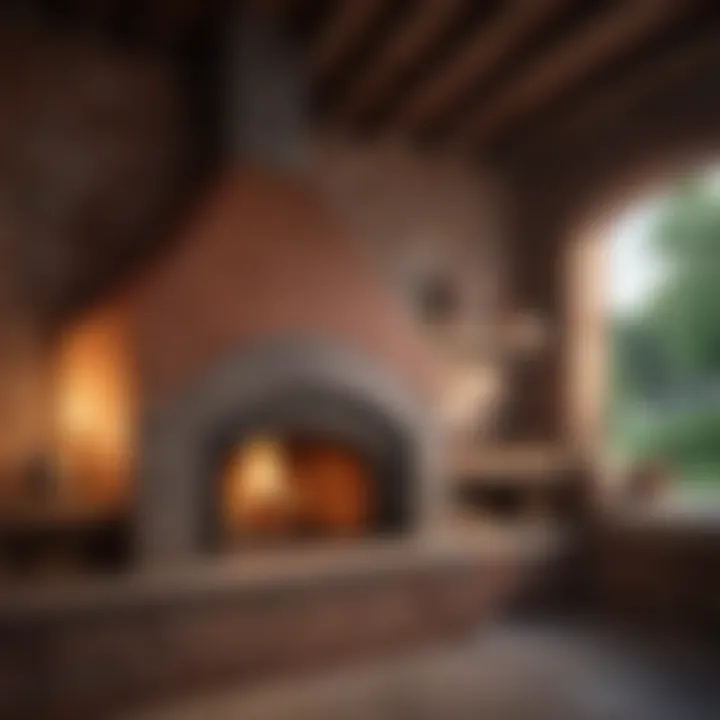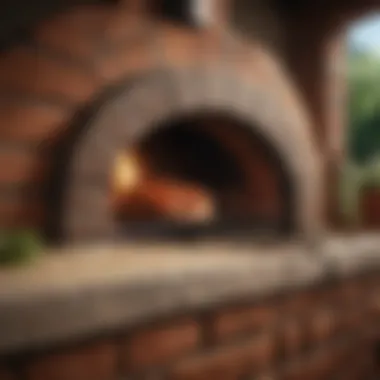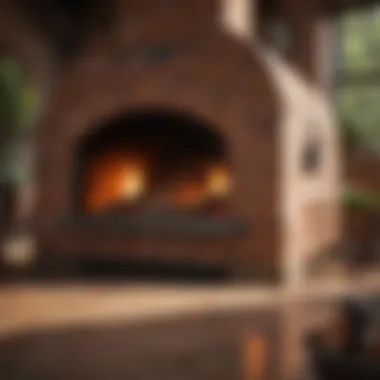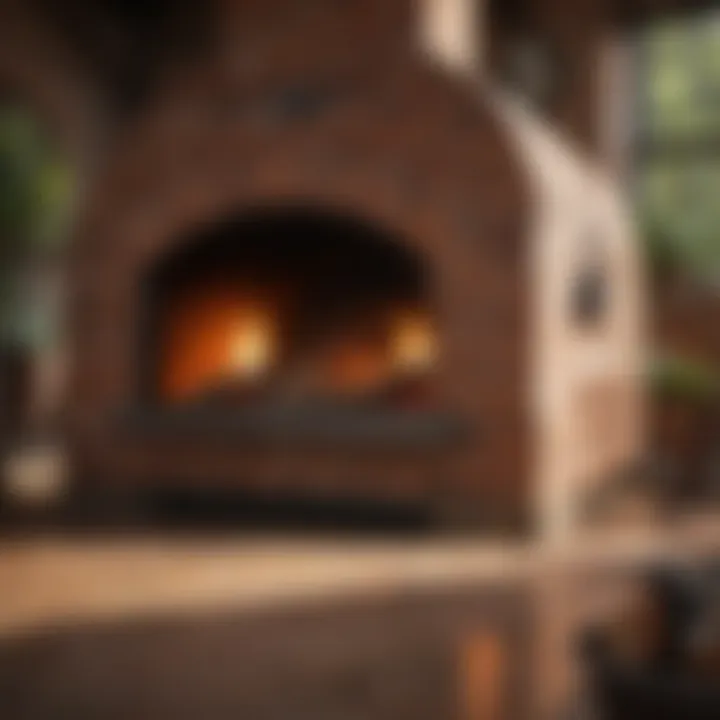Discover Top Brick Oven Pizza Makers for Home Use


Intro
In recent years, there's been a renaissance in home cooking, and few things capture the spirit of culinary creativity quite like brick oven pizza. The beauty of this culinary endeavor lies in its ability to transform simple ingredients into a gourmet meal, all with the distinct flavor that only a wood-fired oven can provide. But diving into the world of brick oven pizza makers can be as daunting as it is exciting. From choosing the right model to understanding the nuances of temperature control, maintenance, and design considerations, one finds that the journey to pizza perfection involves more than just tossing dough.
The following sections will equip you with an understanding of various makers available in the market, their distinct characteristics, and how to fit them into your home lifestyle. Whether you fancy yourself a culinary novice or a seasoned pizza maker, this comprehensive guide aims to decode the intricate world of brick ovens for your home.
Types of Brick Oven Pizza Makers
Understanding the differences among various brick oven pizza makers is critical in making an informed decision. Each type boasts its unique features tailored to different cooking styles and capabilities.
Wood-Fired Ovens
For purists, a wood-fired oven is often the holy grail of pizza-making. These ovens harness the power of actual fire to deliver that sought-after smoky flavor.
- Pros: Authentic taste, extreme temperatures (up to 900°F), can cook pizza in just 90 seconds.
- Cons: Requires wood sourcing, more time-consuming setup, may demand some skill to master.
Gas-Fired Ovens
Gas-fired options are a more modern take and offer the convenience of quicker heat-up times.
- Pros: Easy temperature control, reliable performance, less mess than wood.
- Cons: Slightly less authentic flavor, can be more expensive upfront.
Electric Ovens
If space is limited or you want a simple solution, electric brick ovens are compact and straightforward.
- Pros: Simple to use, ideal for smaller spaces, consistent cooking results.
- Cons: Limited cooking temperatures compared to gas or wood, may not replicate authentic brick oven taste.
Portable Ovens
Perfect for the pizza aficionado on the go, portable ovens make it possible to enjoy stellar pizzas at various locations.
- Pros: Lightweight, easy to transport, good for gatherings.
- Cons: Limited cooking size, may require propane or charcoal for fuel.
Key Features to Consider
When selecting the right brick oven pizza maker, certain features will greatly influence your cooking experience.
- Material Quality: The best models use high-grade materials, such as stainless steel or refractory brick, ensuring durability and excellent heat retention.
- Temperature Control: Some ovens boast advanced temperature settings which can allow customized cooking experiences for different pizza styles.
- Size and Capacity: Think about how many pizzas you envision making at once. Larger ovens fit more but take up more space.
- Heat-Up Time: Quick heat-up time is essential, especially for spontaneous pizza nights. Look for models that reach high temperatures in a short time.
- Ease of Maintenance: Some ovens can be easier to clean. A removable ash tray and easily accessible areas are a plus.
Cooking Methods
There are different cooking methods that can be adapted based on your pizza oven choice and your culinary creativity. The classic method involves the stone cooking base, leading to a crispy crust. There also exist variations where you could experiment with temperature variations and cooking times for creating unique pizza styles.
"The pizza maker is only as good as the technique behind the dough, so practice makes perfect."
Maintenance and Common Issues
Owning a pizza oven also entails a certain level of upkeep. Regular cleaning helps keep it in good shape. Inspecting seals and functionality is a necessity to avoid common pitfalls like inconsistent heating or rendering surfaces unusable.
- Cleaning Tips: Use non-abrasive tools for cleaning, periodically check for ash buildup in wood-burning models.
- Common Pitfalls: Avoid overheating as it may lead to damage, especially in electric models.
With the right tools, ingredients, and passion, brick oven pizza making can become not just a culinary task but an experience to share with friends and family. The guidance shared here should take anyone from uncertain to confident in selecting the perfect pizza maker suited to their cooking needs.
Understanding Brick Oven Pizza Makers
When it comes to crafting the ideal pizza at home, understanding the ins and outs of brick oven pizza makers is vital. This section serves as a foundation, exploring the significance of these ovens in the culinary world. A brick oven can significantly enhance the cooking experience, infusing your pizza with that authentic flavor that often seems elusive.
One notable advantage of brick ovens is their ability to achieve exceptionally high temperatures, around 800 degrees Fahrenheit or more. Unlike conventional ovens, these units allow for cooking pizza in a matter of minutes, resulting in a beautifully charred crust and perfectly melted cheese. It’s not just about speed; it’s about achieving that coveted texture and taste. Moreover, brick ovens are celebrated for their versatility—ideal for baking artisan bread and roasting meats as well as whipping up pizzas.
In this guide, we will delve deeper into specific elements such as construction materials, technologies integrated into these ovens, and how each type caters to different preferences and needs. We'll also examine why certain features hold importance for enthusiasts of home cooking. This understanding sets the stage for making informed decisions when selecting a pizza maker for your kitchen or backyard.
History and Evolution
Brick ovens have a rich history, stretching back thousands of years. Their evolution represents a fascinating journey through time, influenced by cultural and technological shifts. The earliest forms of bread ovens were constructed from clay and used by ancient civilizations, including the Romans and Greeks.
In Italian kitchens, these traditional ovens became synonymous with authentic pizza-making. By the late 19th century, as Italian immigrants brought their culinary traditions to the United States, the influence of brick pizza ovens began spreading. Today, those time-honored techniques meld with modern innovations.
This evolution speaks to an ongoing relationship between convenience and authenticity—what once was a practical necessity remains a symbolic centerpiece for many cooking enthusiasts. Today, options abound, from quaint backyard constructions to sophisticated models used in gourmet kitchens.
Mechanism and Technology
Understanding the mechanisms and technologies driving brick ovens is essential for any homeowner looking to invest. Most traditional brick ovens utilize a combination of brick or stone materials, allowing the kitchen appliance to retain and radiate heat evenly.
These ovens typically employ three key components:
- Heat Source: Whether wood, gas, or electricity, the choice here determines the flavor and ease of use. Each source provides a different flavor profile, contributing to that sought-after authentic taste.
- Insulation: Quality insulation is crucial for maintaining high temperatures. Some ovens are designed with advanced thermal insulation systems that ensure efficiency during cooking while conserving fuel.
- Ventilation: Proper airflow ensures that the heat circulates adequately, giving pizza an even cook. Some models feature adjustable vents, allowing users to control heat levels.
Furthermore, newer models incorporate digital temperature controls and features that enhance user experience. These advancements make it easier than ever to achieve the perfect crust and avoid the common pitfalls associated with using a traditional oven.
In essence, understanding the intricate details of brick oven pizza makers prepares you not only to make a well-informed purchase but also to enjoy the culinary journey these exceptional tools offer.
Types of Brick Oven Pizza Makers
When it comes to crafting the perfect pizza at home, understanding the various types of brick oven pizza makers is crucial. Each type offers distinct benefits and considerations, making certain models more suitable depending on your cooking style and preferences. Whether you're a fan of the smoky flavors that come from wood-fired ovens or prefer the convenience of electric models, knowing these differences can help you make an informed decision. This section aims to illuminate the unique characteristics of each type, aiding enthusiasts in selecting the ideal oven for their culinary endeavors.
Wood-Fired Models
Wood-fired pizza ovens are revered by many culinary aficionados for their ability to produce that quintessential, charred crust and elusive smoky flavor. These ovens typically reach high temperatures quickly, providing an authentic pizza experience reminiscent of traditional Italian pizzerias.


However, the use of a wood fire does require some skill and attention. Considerations include:
- Fuel sourcing: Finding quality, seasoned wood can be a task in itself.
- Temperature fluctuations: Mastering the art of maintaining an even temperature can come with practice.
- Assembly and maintenance: Many wood-fired ovens are larger and may require more effort in setup and upkeep.
Overall, if you crave that robust flavor and are willing to invest the time, a wood-fired model may just become your best kitchen partner.
Gas-Powered Models
Gas-powered models are often seen as the middle ground between convenience and traditional cooking methods. They offer swift heating times and often feature adjustable temperature settings, making it easier to achieve consistent results. These ovens are perfect for those who want to create delicious pizza without the hassle of dealing with wood.
Here’s what you need to keep in mind:
- Fuel availability: Propane tanks or natural gas lines need to be accessible for reliable operation.
- Regulatory considerations: Depending on local regulations, installation may require permits.
- Versatility: Many gas ovens can also be used for roasting or baking, adding more value to your investment.
With their combination of convenience and adaptable cooking, gas-powered models cater to both novice cooks and seasoned chefs alike.
Electric Models
Electric brick oven pizza makers are the ultimate choice for those who prioritize ease of use and compact design. Often lighter and more portable than their wood and gas counterparts, these ovens can fit comfortably in various kitchen spaces or outdoor setups.
Key factors for electric models include:
- Plugging in: Easy access to an electrical outlet is essential for these units.
- Temperature limits: While they heat up quickly, they might not reach the high temperatures of wood or gas ovens.
- User-friendly features: Many come with preset settings and timers, making them ideal for casual cooking or hosting gatherings without the steep learning curve.
If convenience, compact size, and straightforward operation are your top priorities, electric brick oven pizza makers provide a practical solution for pizza enthusiasts.
Choosing the right type of pizza oven is more than just the cooking surface; it’s about enhancing your culinary experience and bringing your vision of a perfect pizza to life.
Understanding the pros and cons of wood-fired, gas-powered, and electric models allows you to align your choice with your culinary aspirations and living space. Each model has unique features that can significantly impact your pizza-making journey.
Key Features to Consider
When setting out to choose a brick oven pizza maker, understanding the key features to consider is essential. It can make the difference between an average pizza and one that transports you to a rustic Italian pizzeria with each bite. Delving into aspects such as material quality, temperature control, cooking capacity, and portability offers clarity in making an informed decision. Each of these elements holds significant weight in the overall cooking experience, helping you whip up pizzas that are not just tasty but consistently delightful.
Material Quality
The material quality of a brick oven pizza maker plays a crucial role in its performance and durability. Often, these ovens are constructed from materials such as stainless steel, ceramic, or refractory bricks. Selecting quality materials ensures that the oven has excellent heat retention and distribution, crucial for achieving that perfect crust.
While ceramic ovens might promise beautiful heat retention, they could be prone to cracking if not handled with care. On the other hand, stainless steel ovens are known for being durable and easier to maintain, making them a popular choice among home cooks. Moreover, high-quality materials also contribute to the aesthetic of the oven, adding a touch of elegance to your outdoor setup.
Temperature Control
Next in line is temperature control, a feature that can't be overlooked. The ability to reach and maintain high temperatures is vital for brick oven pizzas. Ideally, you want your oven to get into the ballpark of 800 to 1000 degrees Fahrenheit for that authentic charred flavor.
Many modern brick ovens come equipped with digital thermometers or adjustable vents, allowing for precise control over the cooking environment. This feature enables you to achieve that coveted Neapolitan touch where the pizza cooks rapidly, resulting in a crispy exterior and chewy interior.
"A pizza should be like a piece of art: perfectly cooked on the outside and a little soft when you bite into it."
Cooking Capacity
Cooking capacity is another critical factor to consider. When hosting gatherings or simply treating your family to a pizza night, the number of pies you can produce in one go matters. Most home brick ovens can fit either a 12- or 16-inch pizza, but some larger models may allow for multiple pizzas at once.
If you often entertain or have a sizable family, a model with higher capacity would undoubtedly serve better. On the flip side, smaller models are more suited for individuals or couples. Think about your cooking habits before choosing.
Portability
Finally, there's portability, which often impacts how and where you can use your brick oven. Traditional built-in types are fixed but can offer a more permanent configuration for your home. However, portable models are gaining traction among pizza enthusiasts for their versatility and ease of setup.
If you enjoy camping or tailgating, consider a lightweight oven that can be easily transported. On the other hand, if you have the space and plan to use the oven frequently, a stationary model might be the best bet.
Comparative Analysis of Popular Models
When it comes to selecting a brick oven pizza maker, a comparative analysis of the leading models is crucial. This part of the discussion allows prospective buyers to understand the landscape of options available to them and how each model stacks against the others in terms of features, performance, and usability. Such insights shed light not only on the pros and cons of each oven but also help in making a more informed decision tailored to one’s specific needs and culinary ambitions.
High-End Options
High-end brick oven pizza makers, like those from Ooni and Roccbox, bring a premium pizza-making experience right into your backyard. These ovens are often crafted from high-quality materials that allow for optimal heat retention and distribution, ensuring that every pizza emerges with a perfectly charred crust and gooey, bubbly cheese.
What makes these models stand out is their advanced technology. For example, the Ooni Karu 16 can burn wood, charcoal, or gas depending on your preferred fuel source, offering versatility that appeals to various cooking styles. They generally reach high temperatures quickly, often exceeding 900°F (482°C) in a matter of minutes, perfect for Neapolitan-style pizzas.
High-end models not only ensure superior cooking results but also emphasize aesthetic appeal, potentially enhancing outdoor spaces as stylish kitchen features. However, these come with steeper price tags, so it’s wise to consider how often you’ll use them and whether that potential for greater quality aligns with your cooking habits.
Mid-Range Choices
Mid-range options, like those from Bertello or Camp Chef, provide a balance of quality and affordability. They often feature multi-fuel capabilities and can maintain excellent heat for sufficient cooking times, suitable for a range of pizza styles.
These models typically have solid construction but might compromise slightly on material quality and maximum temperature limits compared to high-end models. For instance, the Bertello Outdoor Pizza Oven can reach about 930°F (498°C), which is still quite impressive but requires a bit longer to preheat. The benefits of mid-range options lie in their versatility, which can cater well to amateur chefs looking to elevate their outdoor cooking experience without breaking the bank.
User-friendliness is also a hallmark of mid-range models. They often come with additional features like built-in thermometers and easy-access doors, making them perfect for hosts who wish to impress guests with homemade pizzas without getting bogged down by complicated setups.
Budget-Friendly Picks
For those exploring their pizza-making journey without going all-in, budget-friendly models such as those made by Pizzacraft or Blackstone serve as solid starting points. These don’t often excel in temperature control or build quality but can still create satisfying pizzas when used correctly.
Budget options typically have less insulation, meaning they may struggle to retain heat compared to pricier models. However, many provide decent cooking performance for enthusiasts just digging into home cooking.
Interestingly, some budget models can still achieve amazing results with proper techniques — for example, using a pizza stone can help distribute heat more evenly, compensating for some of the shortcomings in temperature control. Investing in a separate stone can be a good strategy for novices wanting to experiment without a significant financial commitment upfront.
Maintenance and Care


Maintaining a brick oven pizza maker is not just about keeping it looking spick and span; it’s essential for ensuring optimal performance and longevity. Just like you wouldn’t drive a car without regular oil changes, your pizza maker requires similar attention. Over time, grease, flour, and charred bits can accumulate, affecting not only how well it cooks but also the flavors of your delicious pizzas. A good maintenance routine can help in creating the perfect crust that every pizza lover dreams about.
Cleaning Techniques
When it comes to cleaning your brick oven pizza maker, the approach differs based on the material and fuel type. Here are some effective cleaning strategies:
- Immediate Cleanup: After every use, it’s a good habit to scrape off any food residues with a metal peel or a flat scraper. Leaving food particles and grease can lead to unpleasant flavors the next time you bake.
- Deep Cleaning: For a thorough clean, wait until the oven is completely cool. Use a mix of warm water and mild detergent to wipe down surfaces. A non-abrasive sponge or cloth will do the trick without scratching the surface.
- Avoiding Harsh Chemicals: Resist the urge to use harsh chemicals. They can leave behind residues that may affect your pizza. Stick to natural cleaning solutions whenever possible, as they are both safe for your oven and the environment.
- Smoke and Ash Management: If you’re using a wood-fired oven, ashes can build up. Make sure to remove the ashes and burnt wood after each cook. You can even save the ashes for your garden as they can act as a natural fertilizer.
"Regular cleaning and maintenance will allow you to enjoy brick oven pizza at its best, ensuring each slice is a culinary delight."
Seasonal Maintenance Checks
As the seasons change, so do the needs of your oven. It’s wise to implement a seasonal maintenance schedule to keep your brick oven in peak condition:
- Before Winter: Check for any cracks in the bricks that may have developed over the summer. Use a heat-resistant mortar to seal any gaps to prevent water damage during the winter months.
- Pre-Summer Check: After being dormant through cold months, inspect the oven for any environmental wear. This could include checking for mold or mildew that may develop if the oven is damp. A simple wipe with a vinegar solution can take care of any built-up grime.
- Fire Safety: During each seasonal check, ensure there are no flammable materials nearby. Make sure your exhaust or chimney is clear of obstructions to allow proper ventilation.
- Functional Assessment: Always conduct a test run to ensure everything is functioning as it should. This includes checking the ignition system, and burner efficiency if applicable.
By integrating these maintenance routines into your schedule, you’ll not only extend the lifespan of your pizza maker but also enhance your cooking experience, ensuring that each meal you prepare is as delicious as possible.
Common Mistakes to Avoid
When it comes to mastering the art of using a brick oven pizza maker, avoiding common pitfalls can distinguish between a mediocre pizza and an extraordinary one. This section identifies crucial errors that often trip up both beginners and seasoned enthusiasts. Recognizing these missteps not only empowers you as a cook but also enhances your culinary journey. Here, the focus is on refining techniques and ensuring that every pizza baked in your oven is a resounding success.
Overloading the Oven
One of the most frequent mistakes people make is trying to fill the oven to the brim. While it might seem like a good idea to maximize the amount of food cooked at once, overloading can lead to uneven cooking and insufficient airflow within the oven. Imagine cramming a cramped subway car during rush hour; everyone gets jostled and it becomes uncomfortable. Similarly, too many pizzas in your brick oven can mean some sides don’t get the desired crispy texture.
The optimal strategy is to prioritize quality over quantity. Stick to cooking two or three pizzas at a time, depending on the size of your oven. This allows the heat to circulate freely, ensuring that every pizza receives consistent heat. You might also want to keep an eye on the cooking time and make adjustments based on your observations.
Some tips to keep in mind:
- Prioritize smaller batches: Baking in smaller portions gives each pizza the attention it deserves.
- Arrange wisely: If you do cook more than one, place them with sufficient gaps as to not block heat.
- Use a thermometer: This handy tool helps you maintain the desired temperature, giving you the confidence to adjust as needed.
Neglecting Temperature Preheating
Many home cooks underestimate the significance of preheating their brick ovens. It’s a crucial step, much like letting a car engine warm up before a long drive. Failure to preheat properly can result in raw dough and undercooked toppings. The oven needs time to reach its ideal temperature, usually around 800 to 900 degrees Fahrenheit, before you slide in the pie.
Preheating serves to create the appropriate baking environment, allowing the crust to rise adequately and become golden brown, while toppings cook evenly.
Here are a few reasons to never skip this step:
- Better crust: Preheating ensures a crispy, delightful crust, as the dough leavens beautifully.
- Flavor enhancement: Ingredients toasted at the right temperature develop flavors and aromas that make for a more satisfying pizza.
- Consistency: Your pizzas will cook in uniformity, preventing common issues like burnt edges or doughy centers.
When preheating, take note of these pointers:
- Check the temperature: Invest in an infrared thermometer or check the thermometer inside the oven if you have one.
- Give it time: Let the oven sit for at least 30 minutes to an hour, depending on the type.
"A good pizza is like a good symphony: every ingredient plays its part, and timing is everything."
By steering clear of overloading your oven and prioritizing proper preheating, you can elevate your pizza-making game tremendously. The joy of achieving that perfect pie is well worth the extra attention to these details.
Culinary Techniques for Perfect Pizza
When it comes to crafting the perfect pizza, the technique in every step of the process can mean the difference between a good pie and a truly great one. Mastering culinary techniques for pizza not only elevates the flavor but also enhances the overall experience of sharing a meal with friends and family. It transforms your kitchen into an arena where flavors collide, textures play, and memories are made over delicious bites. Whether you’re an occasional cook or a seasoned pizzaiolo, honing these techniques can deepen your appreciation for this timeless dish.
Dough Preparation Tips
The foundation of any pizza is the dough. Proper preparation can make or break your pizza-making prowess. Here are some invaluable tips:
- Choose Quality Ingredients: Use high-protein flour, ideally a specific pizza flour like tipo 00, for a chewier crust.
- Kneading Technique: Don’t rush this part. Kneading develops gluten, which gives the dough structure and elasticity. Aim for a smooth, stretchy consistency.
- Fermentation: Allow your dough to rise slowly. A longer fermentation, usually 24 hours or more, can enhance flavor complexities. Cold fermentation in the fridge is a common method.
- Proper Shaping: When stretching the dough, avoid using a rolling pin; instead, use your hands. This technique keeps the air bubbles intact, resulting in a light, airy crust.
"Great pizza starts with great dough. If your dough isn't right, don't bother with the toppings."
Topping Combinations
Creating the perfect toppings can be seen as an art. It's all about balancing flavors, textures, and colors. Here are some pairing ideas:
- Classic Margherita: Tomato sauce, fresh mozzarella, and basil. Simple yet iconic. The freshness of basil offers a delightful contrast to the rich tomatoes.
- White Pizza: Ricotta cheese, mozzarella, and sprigs of spinach. This combination is creamy and slightly earthy, perfect for a unique twist.
- Barbecue Chicken: Toss grilled chicken in barbecue sauce, add red onions and cilantro, and top it off with a mix of mozzarella and cheddar. This flavor packed option is a guaranteed crowd-pleaser.
- Vegetarian Delight: Use grilled zucchini, bell peppers, and olives. A drizzle of olive oil and some feta can take it over the top.
- Fusion Flavors: Try unexpected combinations like spicy chorizo with pear slices and gorgonzola, yielding a complex flavor profile that surprises the palate.
Remember, when layering toppings, don't overload. A well-crafted pizza needs balance. Delicate toppings demand a light touch and even distribution for optimal cooking.
Using these culinary techniques ensures your pizzas will not only impress your dinner guests but also allow for a deeper exploration into the world of homemade pizza. The joy of creating something so flavorful and wholesome is unmatched, inviting moments of community and connection.
Pairing Pizza with Beverages
Pairing pizza with beverages isn’t just a nice touch; it can elevate your dining experience to a whole new level. The right drink can enhance the flavors of the pizza and create a harmonious meal that pleases the palate. Home cooks and party hosts often overlook this element, but taking the time to choose complementary beverages can turn a simple pizza night into a memorable feast.
When selecting beverages, consider the ingredients in your pizza and how they interact with drinks. For instance, the sauce, cheese, and toppings all have different flavor profiles. Understanding these profiles allows you to match them with wines or beers that enhance, rather than clash with, the taste of your dish. Also, the season or occasion can influence your choices—fresh, light wines during summer versus fuller beers in colder months.
- Key considerations include:
- Balance flavors: Aim to complement and contrast to create a well-rounded experience.
- Acidity matters: Tomato-based sauces, for instance, pair well with acidic wines.
- Texture and body: Match lighter pizzas with lighter drinks and heavier pizzas with fuller-bodied options.
This section is about making those decisions easier. Let’s dive deeper into two popular beverage categories: wine and craft beer.
Wine Pairings
Wine can be a delightful companion to pizza, transforming an ordinary meal into a culinary delight. The key is to pair the wine with the main flavors in the pizza. Here are some classic options:
- Neapolitan pizza—Pair with a Chianti or a fruity Pinot Noir. The acidity in these wines balances the tomato sauce beautifully.
- White pizzas with ricotta or mozzarella can go well with a crisp Sauvignon Blanc, which cuts through the creaminess.
- Meat-laden pizzas, like a pepperoni or sausage pie, are often best enjoyed with a robust Cabernet Sauvignon that can stand up to the strong flavors.


A good rule of thumb is: If you can find a region that matches both the pizza and the wine, you're likely heading in the right direction.
Craft Beer Pairings
Craft beer offers a vast array of flavors and styles, making it an ideal companion for pizza. It’s all about finding beers that can either enhance or balance the flavors of your chosen toppings. Here are some interesting matches:
- Margherita pizza—Try a light-bodied Pilsner. Its clean, refreshing taste matches the simplicity of the fresh ingredients.
- BBQ chicken pizza—Pair with an American IPA. The hoppy bitterness contrasts wonderfully with the sweetness of the BBQ sauce.
- Vegetable pizzas—A Hefeweizen is a great choice, thanks to its light, fruity characteristics that highlight the freshness of the vegetables.
Much like with wine, craft beer can enhance many of the flavor notes in pizza, allowing for a well-rounded dining experience.
Building or Buying Your Own Brick Oven
The choice between building or buying a brick oven is not merely about preference; it encapsulates a range of practical considerations that every pizza enthusiast should weigh. A well-crafted brick oven can become a centerpiece of culinary experiences and social gatherings, providing an authentic touch to homemade pizzas. Yet, the pathway to owning one can differ vastly depending on your budget, space, and personal inclination towards DIY projects.
DIY Brick Oven Projects
Opting for a do-it-yourself approach can be rewarding, both in terms of satisfaction and cost-effectiveness. Constructing your own brick oven allows for personalization; you can adapt the design to fit your specific needs.
Before diving in, consider the following elements:
- Location: Select a space with ample ventilation and away from flammable materials. Ideally, this should be in your backyard or patio area.
- Materials: Common choices include firebricks and clay. Investing in quality materials will ensure durability, which is crucial in withstanding high temperatures.
- Time Commitment: Building a brick oven is no small feat. Expect several days or even weeks for completion, depending on your skill level.
- Design Options: There are various designs available online. Some popular styles include the igloo-type oven or the rectangular variant, known for better heat retention.
A basic design may look like this:
This illustration emphasizes a traditional dome shape, ideal for achieving the even heat distribution that is crucial in pizza baking.
In online communities like Reddit or Facebook groups, many enthusiasts share their projects, tips, and pitfalls to avoid, making it easier to build something both functional and aesthetically pleasing.
Factors to Keep in Mind When Buying
If the DIY route feels too daunting, buying a pre-made brick oven can be a quick and efficient solution. However, there are essential factors to consider.
- Budget: Pre-made ovens can vary significantly in price. Set a realistic budget that encompasses not only the oven itself but also setup costs.
- Size: Assess the available space in your yard and your cooking needs. A smaller oven might suffice for personal use, but larger gatherings may require extra capacity.
- Material Quality: Ensure that the oven you’re buying is constructed from high-grade materials. Ovens made from refractory clay or heavy-duty steel are generally preferred as they offer better heat retention and durability.
- Warranty and Support: Research the manufacturer's warranty and customer service reputation. A reliable warranty can provide peace of mind, especially for expensive models.
- Accessibility of Parts: If repairs or modifications are needed, it’s beneficial to choose brands that offer readily available parts. This consideration enhances longevity and eases maintenance efforts.
Ultimately, the decision between building your own brick oven or purchasing one boils down to balancing budget, effort, and desired quality. Both paths can enhance your culinary creations, leading to unforgettable pizza nights with friends and family.
Exploring Regional Pizza Styles
Understanding regional pizza styles offers a deeper appreciation for the craft of pizza-making. Each style carries with it the geographical influences, cultural background, and local ingredients that define its character. When you’re exploring brick oven pizza makers, knowing these different styles can enhance your cooking experience and help you appreciate the unique qualities of each type. Whether you lean towards a specific flavor profile or cooking technique, there’s something to learn from every style. It allows pizza enthusiasts to experiment with recipes and techniques, elevating their home pizzas beyond the ordinary while fostering creativity.
Neapolitan
Neapolitan pizza is widely regarded as the quintessential pizza, hailing from Naples, Italy. It embodies the essence of simplicity and fresh ingredients. The crust is thin, soft, and pliable, with a slight char from the high-temperature cooking characteristic of brick ovens. Traditionally, a Neapolitan pizza is topped with San Marzano tomatoes, fresh mozzarella di bufala, fresh basil, and a drizzle of olive oil. Each bite transports you to a bustling Italian piazza, where it is often eaten with your hands.
Key elements of Neapolitan pizza include:
- High Temperatures: Authentic Neapolitan wood-fired ovens reach up to 900°F (about 480°C), giving the pizza its signature crisp texture.
- Quality Ingredients: Using top-grade ingredients is non-negotiable; this pizza respects the richness of natural flavors.
- Hand-Tossed Dough: The dough is prepared with care, proving its cultural heritage. The tossing technique creates the ideal air pockets in the crust.
"It's not just pizza; it's an experience that wraps you in Italian culture and tradition."
New York Style
Next up, we stroll to the streets of New York City, where the New York-style pizza reigns supreme. It's characterized by large, wide slices that are usually eaten folded in half. The dough is hand-tossed, but it’s a bit thicker and crispier than its Neapolitan counterpart. While toppings can vary widely, a classic choice includes tomato sauce and a generous layer of mozzarella cheese.
Features of New York-style pizza are as follows:
- Size and Flexibility: Growing up, many New Yorkers relied on the convenience of a large slice from a corner pizzeria, perfect for a quick lunch.
- Easy to Customize: From pepperoni to veggie overload, the choices are almost endless, making it a crowd-pleaser at gatherings.
- Simple Yet Flavorful Sauce: The sauce tends to be a bit sweeter and thicker, balancing the saltiness of cheese and toppings nicely.
Chicago Deep Dish
Chicago deep-dish pizza presents a dramatic contrast with its height and hearty nature. This version features a thick crust that comes up the sides of a deep dish pan, creating room for layers upon layers of cheese, meats, and vegetables, all topped with a chunky tomato sauce. Eating a slice of Chicago deep dish is like serving your own little pizza pie, a meal unto itself.
Key characteristics include:
- Layers of Flavor: The construction of deep-dish pizza lends itself to an intricate layering system. Cheese upon the crust, followed by toppings, and crowned with sauce.
- Baking Technique: It’s baked in a pan and often requires longer cooking times, resulting in a hearty, warming dish.
- Perfect for Leftovers: Many claim it tastes even better the next day, making it a wise choice for planned dinner gatherings.
In summary, understanding these regional styles can broaden your pizza-making horizons. Each style, whether Neapolitan, New York, or Chicago deep dish, leads to unique interpretations that bring different flavors and eating experiences to your table.
The Future of Pizza Making
The world of pizza making is ever-evolving, shaped by both technological advancements and a growing awareness of sustainability. Understanding this evolution allows both aspiring chefs and seasoned enthusiasts to adapt to changing trends. With increased access to high-quality ingredients and tools, the home pizza experience is becoming more refined. By looking towards the future, one can grasp how innovations can enhance flavors and streamline the cooking process. The future of pizza making promises not only to elevate the taste but also to ensure that the craft remains environmentally considerate.
Innovations in Cooking Technology
The innovations in cooking technology are shaping the pizza-making landscape, and these changes are quite exciting. For example, emerging heated surface technologies are ensuring that ovens can reach higher temperatures more efficiently, creating that sought-after crispy crust in less time. You might find it fascinating that some modern ovens even integrate smart technology, allowing users to control temperature and cooking time right from their smartphones.
Benefits of these innovations include:
- Precision Cooking: Smart meters and indicators are allowing for more precise control over temperature, ensuring every pizza is cooked to perfection.
- Quick Preheat Times: With advancements in the heating element design, some models now preheat in mere minutes.
- Energy Efficiency: New modes of energy consumption mean less waste while still yielding delicious results.
- Enhanced User Experience: Many cutting-edge models come with digital interfaces that guide users through the cooking process, from selecting temperatures to timing.
Moreover, newer models often use materials that retain heat more effectively, keeping the cooking environment stable, thus further enhancing the quality of the pies produced. In the kitchen of the future, cooking a brick oven pizza may soon become as simple as following a recipe on your tablet.
Sustainability Considerations
In the realm of pizza making, there’s a clear movement towards sustainability. As consumers become more eco-conscious, the demand for environmentally friendlier cooking practices has surged. Incorporating sustainable practices not only minimizes waste but also augments the overall pizza-making experience.
Some important sustainability considerations include:
- Sourcing Local Ingredients: Emphasizing locally sourced, organic ingredients not only supports local economies but also reduces the carbon footprint associated with transporting food.
- Energy Sources: Opting for ovens that use renewable energy sources, such as solar-powered options, can significantly lower the ecological impact of pizza making.
- Waste Reduction Practices: Many pizza makers are beginning to embrace composting techniques, ensuring that food waste is kept to a minimum. For example, any leftover dough scraps can be composted instead of thrown away.
- Recyclable Materials: When purchasing new equipment, look for models made from recyclable or sustainable materials that minimize environmental degradation.
"Sustainability isn’t just a trend; it’s a commitment to the future of food culture."
As we move forward, it’s important to consider how these innovations and sustainability efforts work hand-in-hand to cultivate a better pizza experience, both for the palate and for the planet. While enjoying a delicious slice, one can feel good knowing that efforts are being made for future generations to indulge as well.







